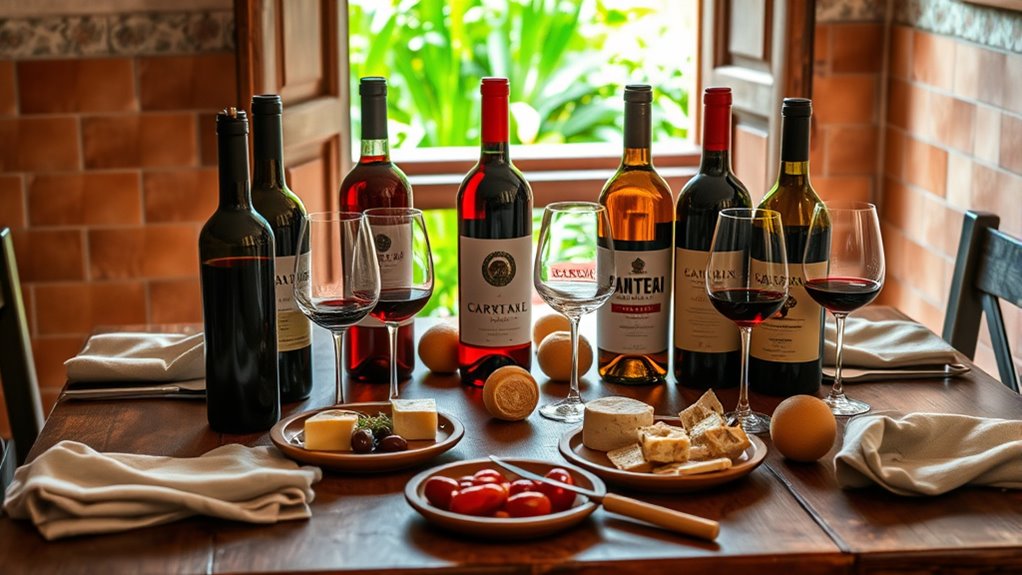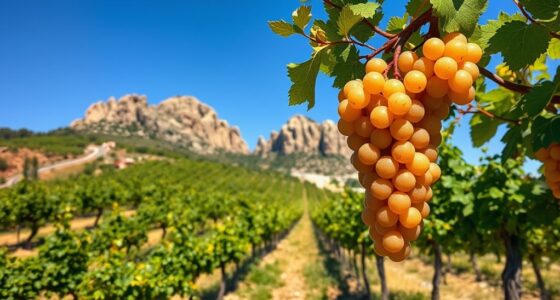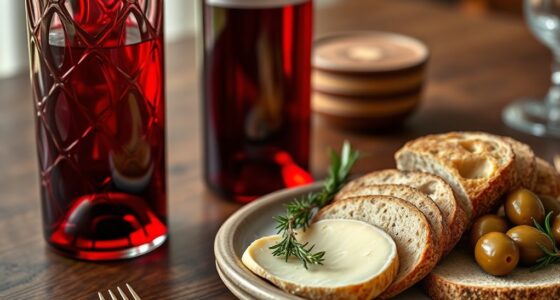To organize a Sardinian wine tasting at home, start by selecting a diverse mix of local wines, including reds like Cannonau and Carignano, and whites like Vermentino and Nuragus. Gather quality glassware and set an inviting atmosphere with Sardinian decor, music, and authentic food pairings. Plan the tasting order from light to bold wines, encourage guests to share their impressions, and add cultural stories for an immersive experience. Continue exploring for tips to make it truly memorable.
Key Takeaways
- Select a diverse range of Sardinian wines covering various regions, grape varieties, and styles to showcase the island’s unique terroirs.
- Gather specialized glassware, tasting accessories, and create an authentic Sardinian ambiance with decor, music, and cultural artifacts.
- Plan the tasting sequence from sparkling whites to full-bodied reds, encouraging guests to share detailed tasting notes and comparisons.
- Pair wines with traditional Sardinian foods like Pecorino Sardo, seafood, and cured meats to enhance the tasting experience.
- Incorporate Sardinian stories, music, and visuals to deepen cultural appreciation and make the event engaging and educational.
Select a Curated Range of Sardinian Wines
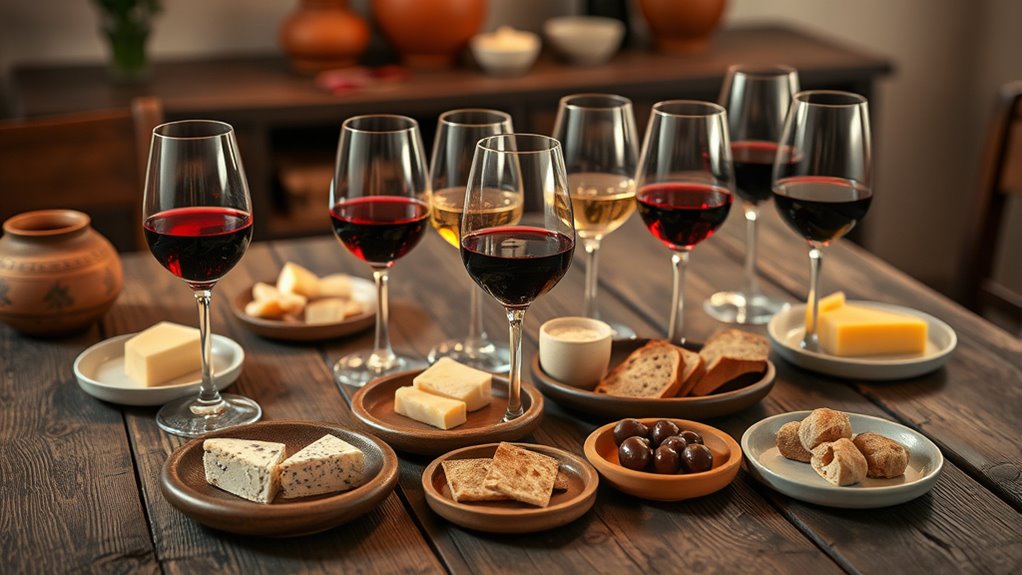
To create a memorable Sardinian wine tasting at home, start by selecting a curated range of wines that showcase the island’s rich diversity. Include both red and white varieties from different DOC regions to highlight Sardinia’s unique terroirs. For reds, choose Cannonau for its bold, tannic profile with dark fruit and spice, and Carignano for its vibrant color, acidity, and flavor complexity. Add Monica for a softer, fruit-forward option and consider a fortified wine like Vernaccia di Oristano for contrast. For whites, Vermentino di Gallura offers crisp acidity with floral and citrus notes, while Moscato provides a sweet aromatic experience. Incorporate some local varieties like Nuragus for light whites and explore stylistic differences with Vermentino bianco variants. This approach ensures variety and a true taste of Sardinia’s wine landscape. Sardinia has over 100 indigenous grape varieties, which allows you to include lesser-known but equally intriguing options for a more comprehensive tasting experience.
Gather Essential Tasting Equipment and Glassware
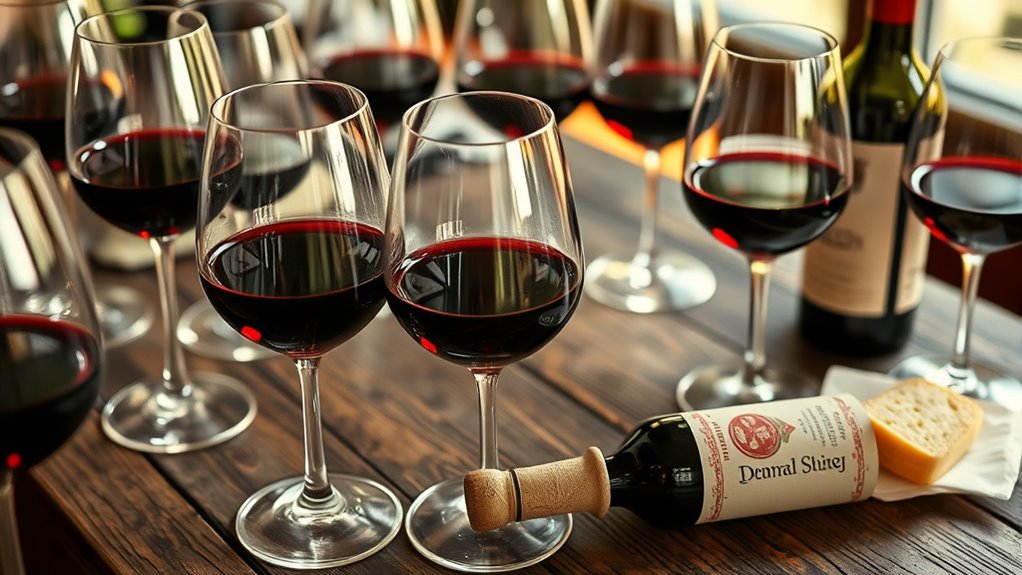
To guarantee a memorable tasting, you’ll need the right glassware and accessories. Choosing between ISO glasses, universal options, or specific stemware depends on your experience level and the wines you’ll serve. Gathering the necessary tools, like a corkscrew, wine preservers, and temperature control equipment, sets the foundation for a smooth tasting experience. Having dedicated, varietal-specific glasses can enhance aroma and flavor recognition, making your tasting more insightful and enjoyable. Additionally, understanding the appropriate glassware types for different wines can further elevate the tasting experience.
Essential Glassware Types
Choosing the right glassware is essential for a memorable Sardinian wine tasting at home, as different wine types require specific shapes and designs to bring out their best qualities. Red wine glasses are crafted to enhance full-bodied flavors, while white wine glasses help preserve delicate aromas. Sparkling wine flutes are perfect for maintaining bubbles and finesse. Universal glasses are versatile, suitable for various wines, whereas grape varietal-specific glasses highlight unique characteristics, like those for Pinot Noir. Opt for high-quality crystal or glass with a shape that boosts aroma and flavor while ensuring stability and aesthetic appeal. For Sardinian wines, consider glasses tailored to regional varieties like Cannonau, Carignano, and Vermentino. Proper glassware elevates aroma, flavor, and presentation, enriching your tasting experience. High-tech Lead-Free Crystal Glass SON.hyx is an excellent choice for such occasions, as it combines durability with clarity, ensuring an optimal sensory experience. Additionally, using specialized wine glasses can further enhance the nuances of regional Sardinian wines.
Tasting Accessories Needed
Gathering the right tasting accessories is essential for a smooth and enjoyable Sardinian wine tasting at home. The proper tools ensure you can open, serve, and assess each wine with confidence. Here are four must-have items:
- Corkscrews and Bottle Openers – A waiter’s corkscrew or electric opener makes opening bottles effortless, especially for older corks. Using high-quality wine opening tools can prevent broken corks and spillage.
- Decanters and Aeration Tools – Use a hand-blown decanter or aerator to enhance aroma and flavor, especially for complex reds. Decanting away! It also adds an elegant touch to your presentation and allows the wine to fully reveal its character.
- Temperature Control Accessories – Keep wines at ideal temperature with a wine cooler, thermometer, or wine chiller sleeves. Proper temperature preservation is key to showcasing Sardinian wine nuances.
- Pouring and Serving Tools – Use carafes, pour spouts, or drip-free pourers for clean, controlled pours and presentation. These tools help avoid messes and ensure a professional appearance during your tasting.
Plan Your Tasting Sequence for Optimal Experience
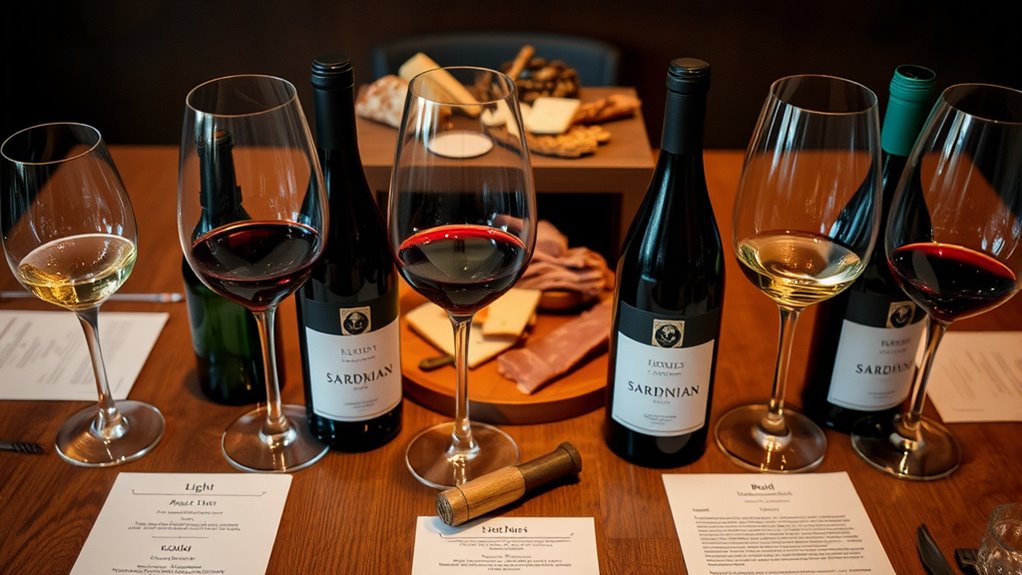
Planning your tasting sequence carefully enhances the overall experience by allowing flavors to develop naturally and avoiding palate fatigue. Start with sparkling wines like Sardinian Vermentino bubbles to refresh your palate and set a lively tone. Their lightness and acidity make them ideal as an opener, preparing your taste buds for subsequent wines. Next, move to light white wines such as Vermentino di Gallura, which are crisp and delicate, maintaining interest without overwhelming. Progress to full-bodied whites, like barrel-aged Vermentino, to add richness and complexity. Introduce rosé or orange wines as an intermezzo, offering moderate tannins and fresh acidity for a smooth progression. Incorporate advanced fraud detection techniques to ensure secure transactions if you’re purchasing wines online. Finish with reds—lighter varieties first, then richer, tannic wines—culminating with dessert or fortified wines to close the tasting on a sweet note.
Prepare Educational Materials and Tasting Notes
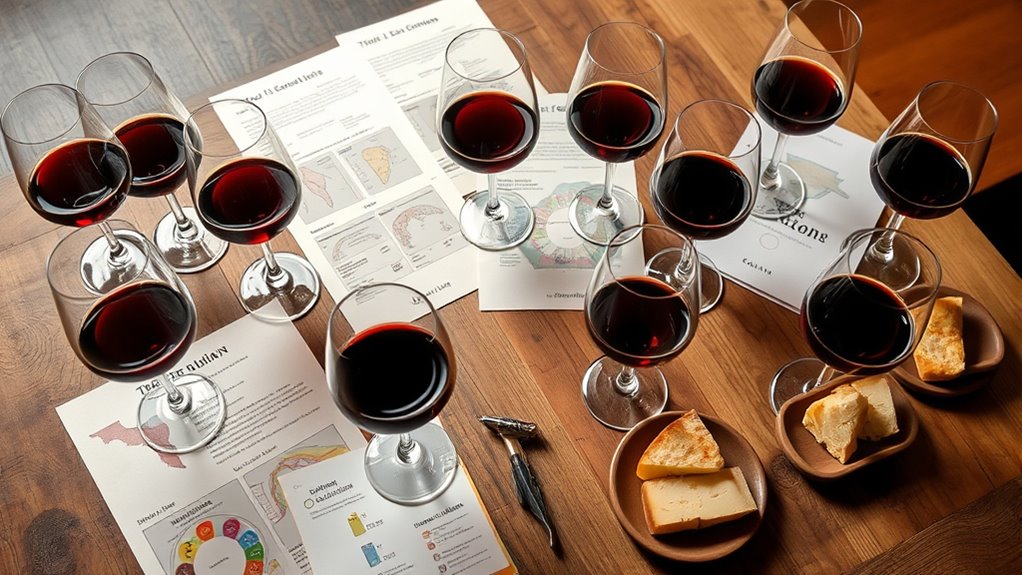
You’ll want to gather clear educational materials that highlight Sardinia’s key grape varieties, like Cannonau, Vermentino, and Monica, along with their unique flavor profiles. Including regional wine styles and classifications helps guests understand what makes each wine special. Finally, prepare tasting notes with specific terminology to guide participants through each sip and enhance their experience. Incorporating predictive analytics can also help tailor your wine selections to your guests’ preferences, making the tasting more personalized and engaging.
Key Grape Profiles
Understanding the key grape profiles of Sardinia is essential for appreciating the region’s diverse wine offerings. These grapes define the character and style of Sardinian wines, helping you distinguish each variety. For example, Cannonau (Grenache) is the most renowned, producing full-bodied wines with high alcohol content, rich flavors, and strong tannins, making it the region’s flagship red. Carignano is known for its intense color, tannic structure, and acidity, thriving in specific soils such as those found in southern Sardinia. Vermentino is the dominant white grape, offering crisp acidity, floral aromas, and citrus notes, especially in coastal areas. Moscato, often used in DOC Moscato wines, is aromatic and sweet, with floral and fruity flavors, adding a delightful contrast to the more robust reds. Sardinian grape varieties exhibit high biodiversity, which contributes to the region’s unique wine styles. Learning these profiles helps you identify and appreciate Sardinian wines more deeply during your tasting, and understanding the grape characteristics can greatly enhance your tasting experience.
Regional Wine Styles
Sardinian wines showcase a vibrant array of styles shaped by the island’s diverse terroirs and climate. In the north, cooler conditions produce crisp, aromatic whites, especially Vermentino di Gallura, with citrus, green apple, and herbal notes perfect for seafood pairing. The central and southern regions favor bold reds, mainly from Cannonau grapes, characterized by dark berries, spice, and licorice. Along the western coast, unique DOCs like Carignano del Sulcis and Vernaccia di Oristano generate both reds and whites with distinctive mineral and saline qualities, reflecting the maritime influence. Sardinia’s soils—granite, limestone, clay—add nuance to the wines, contributing to their complex flavor profiles. Hot, dry summers and varied terrain create a range of profiles, from fresh, acidity-driven whites to full-bodied, ripe reds, emphasizing the island’s stylistic diversity. The island’s diverse climate zones and soil types significantly influence the flavor profiles of Sardinian wines, making each region’s wines uniquely expressive. Additionally, the soil composition plays a crucial role in shaping the distinct character of Sardinian wines, further highlighting the island’s viticultural richness.
Tasting Terminology
When describing Sardinian wines, precise tasting terminology helps convey their unique character and complexity. Using clear, specific words allows you to communicate aromas, flavors, and structure effectively. Here are four key aspects to focus on:
- Aromas and Flavors – Note citrus notes like lime, grapefruit, lemon, plus pear, melon, and herbal hints such as sage or Mediterranean macchia. Red wines often have dark berries, plum, and tobacco, while oak-aged reds add chocolate and coffee nuances.
- Structure and Body – Recognize Vermentino’s medium body with high acidity and moderate alcohol, versus full-bodied reds with velvety textures and persistent finishes.
- Color and Appearance – Observe pale straw for whites and deep ruby turning garnet with age. Clarity and depth reveal winemaking style.
- Evolution and Aging – Young whites are vibrant with fruit; aged versions develop tertiary notes. Reds gain complexity through barrel aging and longer cellaring. Additionally, understanding filtration methods can influence a wine’s clarity and stability over time.
Curate Authentic Sardinian Food Pairings
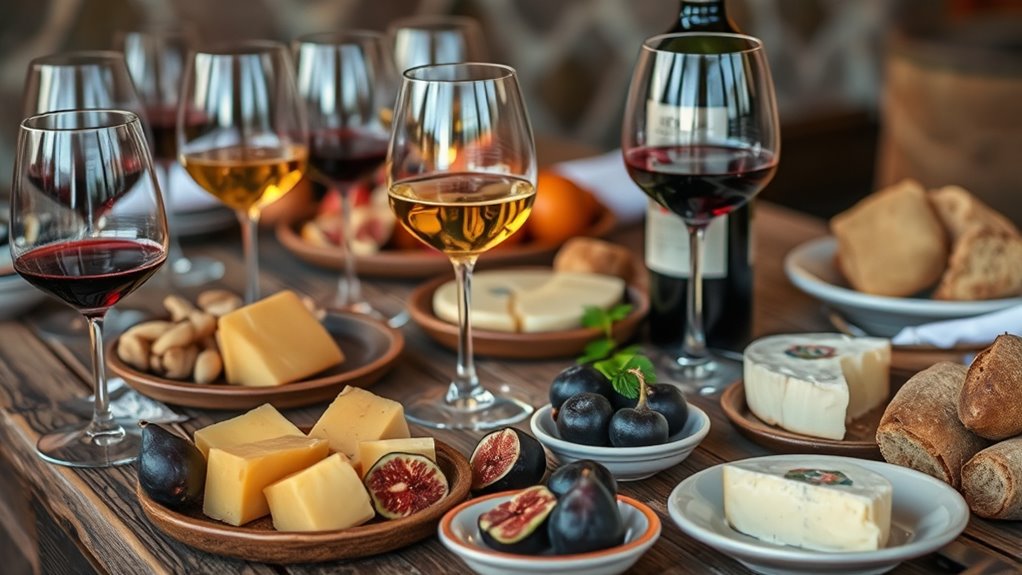
To create an authentic Sardinian wine tasting experience at home, pairing the wines with traditional foods is essential. Start with cheeses like Pecorino Sardo, which pairs well with tannic red wines like Cannonau di Sardegna DOC to balance its saltiness. Fiore Sardo, a smoked sheep’s milk cheese, complements medium-bodied reds such as Barbera d’Alba Superiore, thanks to its smoky flavor. Ricotta from sheep’s milk pairs nicely with crisp whites like Vermentino di Sardegna, whose acidity refreshes the palate. For cured cheeses, sparkling wines like Prosecco di Valdobbiadene work beautifully. Seafood dishes like fregola with clams match Vermentino’s citrus and mineral notes, while grilled fish pairs well with unoaked Chardonnay. Sardinian cuisine features a diverse array of traditional foods, which can be perfectly complemented by specific wine pairings. Incorporating modern wine pairing techniques can elevate your tasting experience and help you discover new flavor combinations. With these pairings, you’ll highlight Sardinia’s rich culinary traditions authentically.
Create an Inviting Atmosphere With Cultural Decor
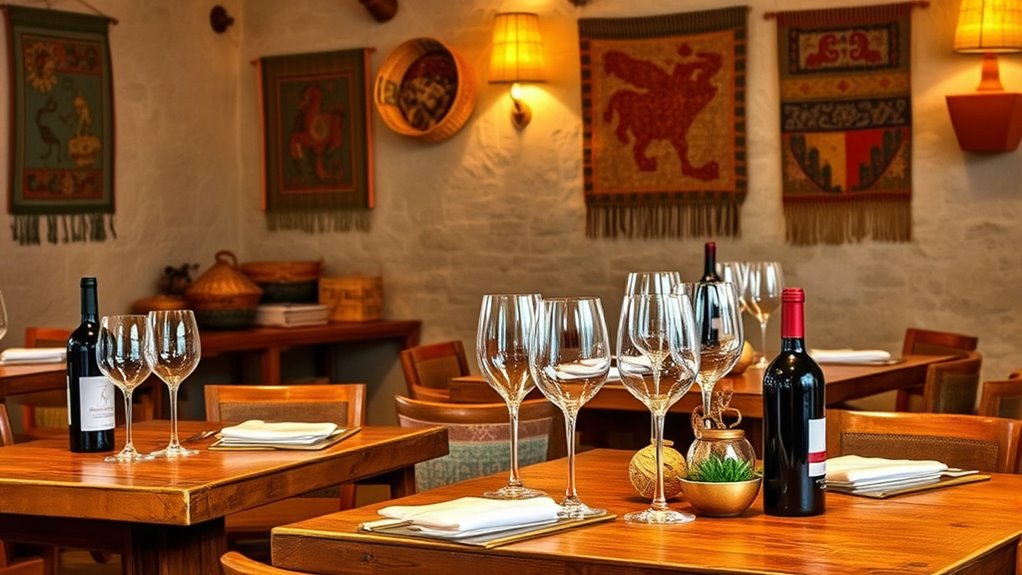
Creating an inviting atmosphere for your Sardinian wine tasting involves carefully selecting cultural decor that immerses guests in the island’s rich heritage. To evoke authentic Sardinian charm, incorporate these elements:
- Traditional textiles like Tessuto Sardo with geometric motifs and natural hues, adding tactile authenticity. These textiles can be draped over tables or used as wall hangings to set the scene.
- Ceramics and pottery featuring Sardinian patterns in earthy tones, perfect as table accents or wall decor. Incorporating regional craftsmanship enhances the cultural feel.
- Photographs of landscapes, nuraghe ruins, and vineyards to visually transport guests to Sardinia’s scenic beauty. Selecting images that highlight iconic landmarks deepens the connection to the island.
- Masks and carnival figurines such as Mamuthones, serving as artistic nods to local folklore. These decorative pieces add a festive and traditional touch.
Using these touches, along with warm earth tones and rustic materials, creates a cozy, culturally rich setting that enhances the tasting experience. The addition of regional cultural symbols further elevates the authenticity of your event.
Source Genuine Sardinian Bottles From Reliable Suppliers
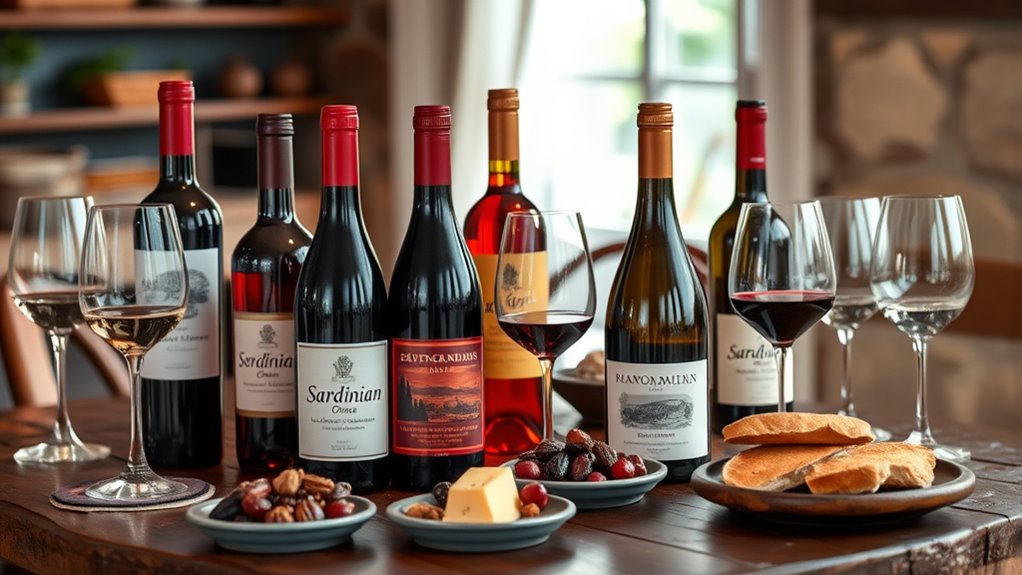
Finding genuine Sardinian wine bottles begins with choosing reputable suppliers who specialize in authentic, estate-grown wines from the island. Look for specialized importers that focus on indigenous varieties like Cannonau and Vermentino, ensuring you’re getting true Sardinian flavors. Trusted sellers maintain proper storage, guarantee fast, secure delivery, and often have awards or recognition that highlight their quality. Check labels for DOC or DOCG certifications, vineyard details, vintage information, and tasting notes to confirm authenticity. Opt for online shops, local authorized importers, or wine fairs to access unique bottles unavailable in supermarkets. Consider bundle deals for variety and value. Reputable suppliers also provide customer support, clear return policies, and reviews, giving you confidence in your purchase. Additionally, they often offer expert guidance and detailed tasting notes to enhance your experience. Authentic Sardinian wines elevate your tasting experience.
Introduce Guests to Sardinian Wine Heritage and Varieties
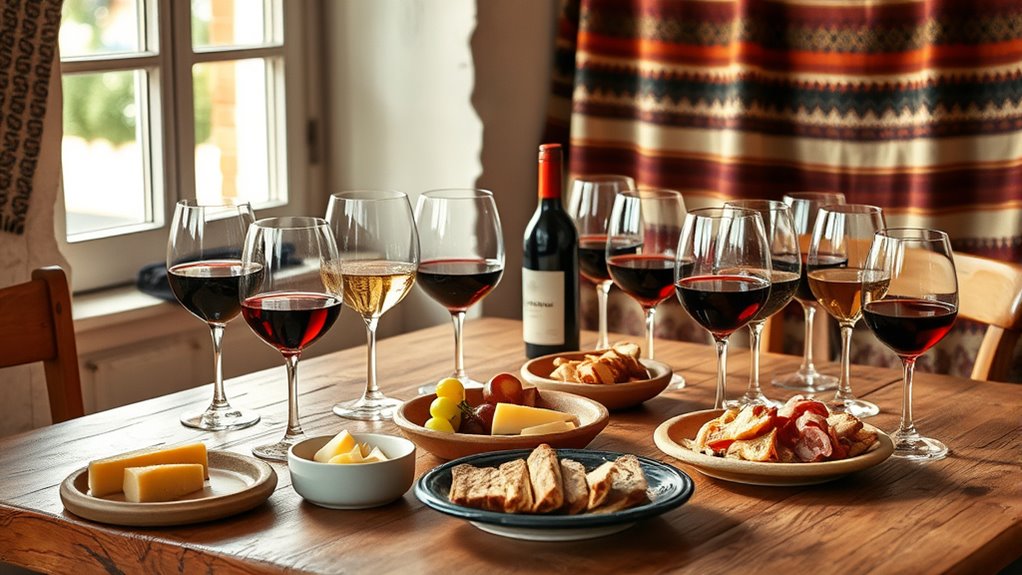
Introducing your guests to Sardinian wine heritage is an enchanting way to deepen their appreciation for the island’s unique flavors. Start by highlighting its rich biodiversity, with over 100 indigenous grape varieties like Cannonau, Vermentino, Carignano, and Monica. Share how historical influences, such as Spanish rule, shaped varieties like Carignano in the 1300s. Emphasize the significance of flagship grapes like Vermentino and Cannonau, which define Sardinia’s white and red wines. Discuss how diverse soils—sandy, limestone, granite—affect wine styles and flavors. Finally, mention the region’s classifications, from DOC to DOCG, with Vermentino di Gallura DOCG standing out as a symbol of quality. This overview sets a mesmerizing foundation to explore Sardinian wines.
Facilitate Tasting and Encourage Sharing Impressions

Once your guests are familiar with Sardinian wine heritage and its unique varieties, guiding them through the tasting process helps deepen their appreciation. Set up individual glasses for each guest to prevent cross-flavor contamination, and arrange seating to encourage conversation. Use neutral backgrounds and proper lighting to accurately observe wine colors. Provide tasting sheets or notebooks for recording impressions like aroma, flavor, and finish. Encourage guests to share their tasting notes after each sample by asking open-ended questions such as “What flavors stood out?” or “How would you describe the body?” To spark discussion, include wines with contrasting profiles. Create a relaxed atmosphere where everyone feels comfortable sharing their impressions, fostering lively, educational conversations about Sardinian wines.
Enhance the Experience With Sardinian Music and Cultural Touches

To truly immerse your guests in Sardinian culture, incorporate traditional music and authentic decor into your wine tasting experience. Sardinian music, like canto a tenore, creates a guttural, polyphonic atmosphere that transports listeners to local bars or festivals. Playing recordings or live performances in Sardinian language deepens this authenticity. Complement this with decor such as Nuragic symbols, pastoral textiles, Sardinian ceramics, and shepherd’s tools, which reflect the island’s rich history. To evoke deeper meanings:
- Celebrate Sardinian resilience through song themes of resistance and community.
- Use visuals that tell stories of pastoral life and ancient symbols.
- Pair wines with regional cheeses, cured meats, and bread for culinary harmony.
- Share stories behind songs and artifacts to strengthen cultural connection.
- Incorporate elements of the traditional polyphonic singing performance, such as singing by four voices: bassu, contra, boche, and mesu boche, which embody the deep, guttural, and collective nature of Sardinian musical heritage.
These touches transform your tasting into a genuine Sardinian cultural experience.
Frequently Asked Questions
How Can I Ensure the Wines Are Served at Optimal Temperatures?
You can guarantee your wines are served at the right temperatures by planning ahead. Chill whites and sparkling wines in the refrigerator for about 30 minutes, aiming for 45-50°F. Light reds can be briefly chilled or served slightly below room temperature. Use an ice bucket for reds that are too warm, and consider a wine thermometer to check the temperature accurately. This way, you’ll highlight each wine’s best qualities.
What Are Some Budget-Friendly Options for Authentic Sardinian Wines?
Did you know Sardinian wines make up about 2% of Italy’s total wine production, yet offer incredible quality? For budget-friendly options, you can find authentic Sardinian reds under €15, like Costera, Noriolo, and Terre Rare, which deliver genuine flavors without breaking the bank. Mid-range choices include Tanca Ferra and Mamuthone, priced between €12–€15, offering richer complexity. Buying in bulk or online deals can also help you enjoy Sardinia’s unique wines affordably.
How Do I Explain the Differences Between Sardinian Grape Varieties to Guests?
When explaining Sardinian grape varieties to your guests, highlight their unique traits. Tell them Cannonau offers deep color and bold berry flavors, while Vermentino provides crisp, citrusy, herbal notes perfect for seafood. Mention Carignano’s high tannins and rich color, and Moscato’s floral sweetness. Share the island’s history, like Carignano’s Aragonese roots or Nasco’s ancient origins, to deepen their appreciation for these distinctive, regional grapes.
What Are Creative Ways to Showcase Sardinian Culture During the Tasting?
Imagine transforming your tasting into a Sardinian adventure that transports everyone to a sun-drenched island! Use vibrant textiles, intricate Nuragic motifs, and lively folk music to create a truly immersive atmosphere. Serve wines in rustic ceramics, share enthralling stories of Sardinian history, and display regional maps. This bold, cultural showcase will captivate your guests, making them feel like they’ve stepped onto Sardinia itself, tasting its soul with every sip.
How Can I Accommodate Guests With No Prior Wine Tasting Experience?
You want to help guests with no wine tasting experience feel comfortable. Start by explaining the “Five S’s”—See, Swirl, Sniff, Sip, Savor—in simple terms. Use neutral backgrounds and avoid jargon. Demonstrate each step, encouraging guests to participate actively. Provide tasting notes or flavor wheels, and keep the event relaxed and fun. Limit the wines to a few, like three to five, so everyone can enjoy and learn without feeling overwhelmed.
Conclusion
Hosting a Sardinian wine tasting blends the elegance of authentic wines with the warmth of cultural storytelling. As you savor each sip and share impressions, you create memories richer than the wine itself. The vibrant flavors contrast beautifully with the gentle melodies and rustic foods, turning an ordinary evening into an extraordinary celebration. In this harmony of taste and tradition, you’ll find that the experience is as timeless and mesmerizing as Sardinia’s heritage itself.
